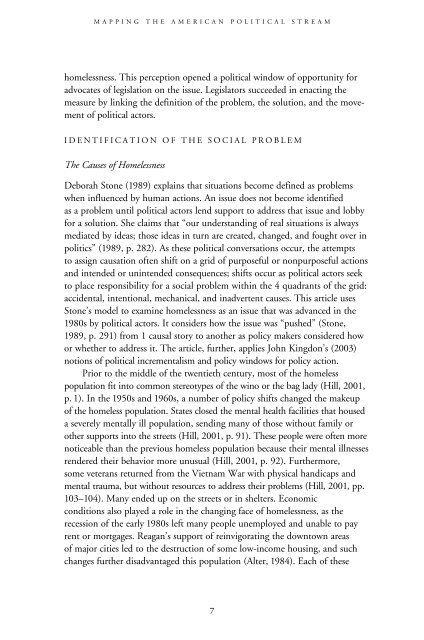2006 - School of Social Service Administration - University of Chicago
2006 - School of Social Service Administration - University of Chicago
2006 - School of Social Service Administration - University of Chicago
Create successful ePaper yourself
Turn your PDF publications into a flip-book with our unique Google optimized e-Paper software.
MAPPING THE AMERICAN POLITICAL STREAM<br />
homelessness. This perception opened a political window <strong>of</strong> opportunity for<br />
advocates <strong>of</strong> legislation on the issue. Legislators succeeded in enacting the<br />
measure by linking the definition <strong>of</strong> the problem, the solution, and the movement<br />
<strong>of</strong> political actors.<br />
IDENTIFICATION OF THE SOCIAL PROBLEM<br />
The Causes <strong>of</strong> Homelessness<br />
Deborah Stone (1989) explains that situations become defined as problems<br />
when influenced by human actions. An issue does not become identified<br />
as a problem until political actors lend support to address that issue and lobby<br />
for a solution. She claims that “our understanding <strong>of</strong> real situations is always<br />
mediated by ideas; those ideas in turn are created, changed, and fought over in<br />
politics” (1989, p. 282). As these political conversations occur, the attempts<br />
to assign causation <strong>of</strong>ten shift on a grid <strong>of</strong> purposeful or nonpurposeful actions<br />
and intended or unintended consequences; shifts occur as political actors seek<br />
to place responsibility for a social problem within the 4 quadrants <strong>of</strong> the grid:<br />
accidental, intentional, mechanical, and inadvertent causes. This article uses<br />
Stone’s model to examine homelessness as an issue that was advanced in the<br />
1980s by political actors. It considers how the issue was “pushed” (Stone,<br />
1989, p. 291) from 1 causal story to another as policy makers considered how<br />
or whether to address it. The article, further, applies John Kingdon’s (2003)<br />
notions <strong>of</strong> political incrementalism and policy windows for policy action.<br />
Prior to the middle <strong>of</strong> the twentieth century, most <strong>of</strong> the homeless<br />
population fit into common stereotypes <strong>of</strong> the wino or the bag lady (Hill, 2001,<br />
p. 1). In the 1950s and 1960s, a number <strong>of</strong> policy shifts changed the makeup<br />
<strong>of</strong> the homeless population. States closed the mental health facilities that housed<br />
a severely mentally ill population, sending many <strong>of</strong> those without family or<br />
other supports into the streets (Hill, 2001, p. 91). These people were <strong>of</strong>ten more<br />
noticeable than the previous homeless population because their mental illnesses<br />
rendered their behavior more unusual (Hill, 2001, p. 92). Furthermore,<br />
some veterans returned from the Vietnam War with physical handicaps and<br />
mental trauma, but without resources to address their problems (Hill, 2001, pp.<br />
103–104). Many ended up on the streets or in shelters. Economic<br />
conditions also played a role in the changing face <strong>of</strong> homelessness, as the<br />
recession <strong>of</strong> the early 1980s left many people unemployed and unable to pay<br />
rent or mortgages. Reagan’s support <strong>of</strong> reinvigorating the downtown areas<br />
<strong>of</strong> major cities led to the destruction <strong>of</strong> some low-income housing, and such<br />
changes further disadvantaged this population (Alter, 1984). Each <strong>of</strong> these<br />
7
















